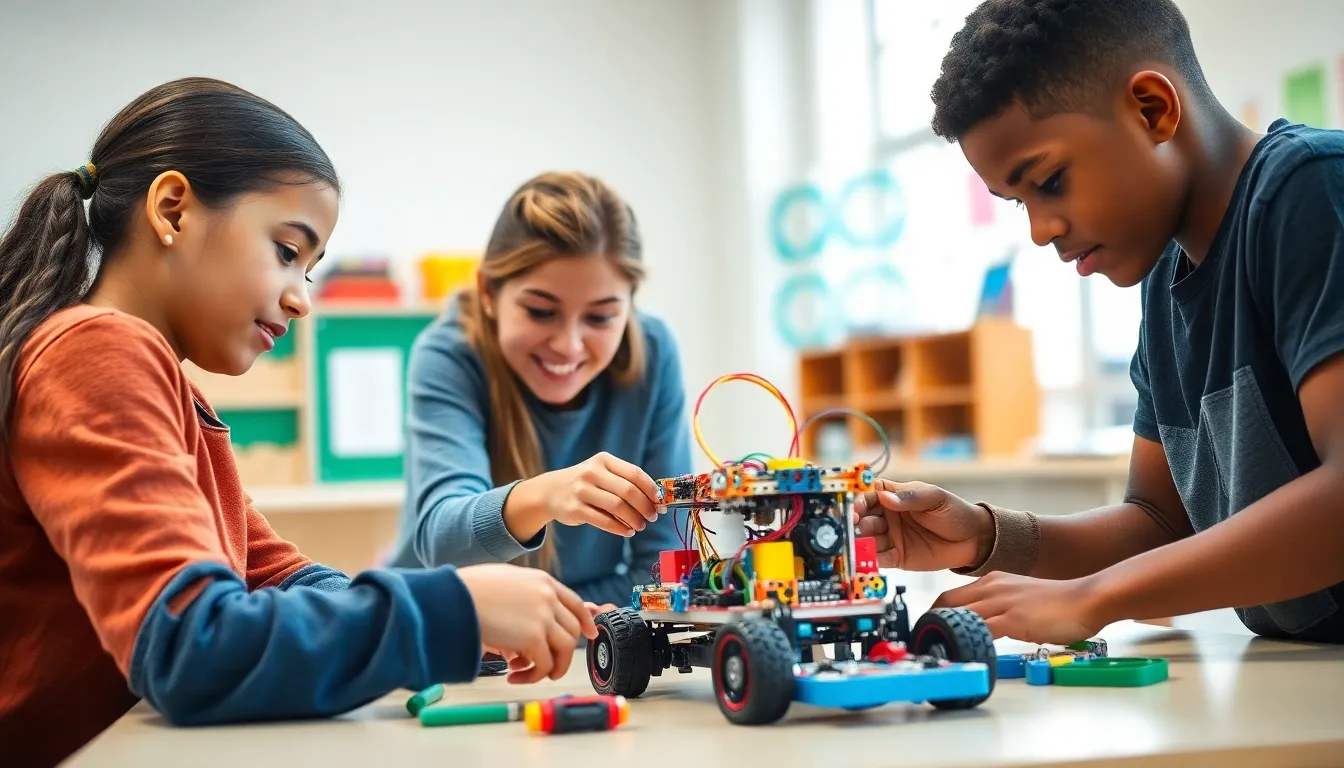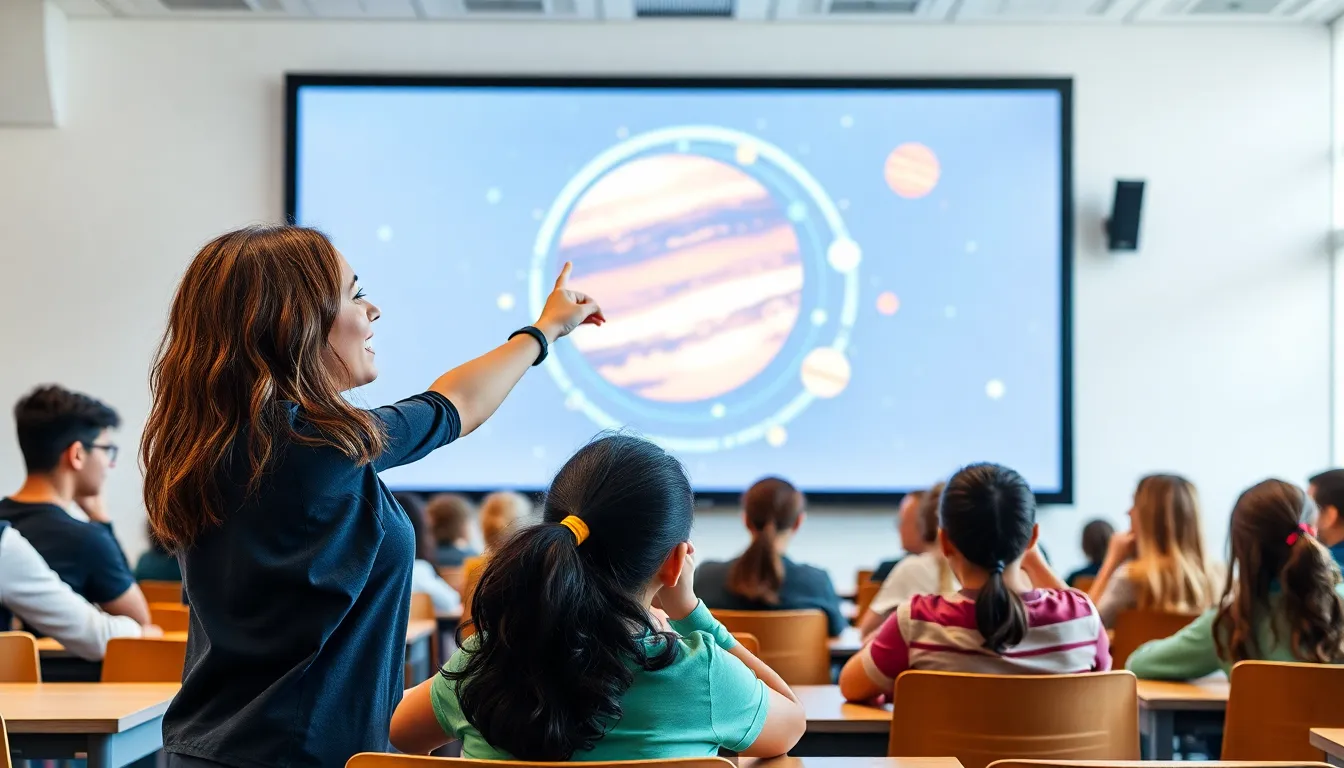In a world where kids can code their own video games and build robots that can dance better than they can, educational robotics is stealing the spotlight. Gone are the days of boring lectures and endless textbooks. Instead, students are diving into hands-on learning experiences that spark creativity and critical thinking. Who wouldn’t want to create a robot that can fetch snacks?
Table of Contents
ToggleOverview Of Educational Robotics
Educational robotics integrates technology and education, emphasizing hands-on learning in various subjects. This approach enhances engagement and fosters essential skills like problem-solving and teamwork.
Definition And Importance
Educational robotics refers to the use of robots in teaching and learning environments. It promotes active learning, allowing students to explore concepts in science, technology, engineering, and mathematics. Engaging with robotics cultivates critical thinking and creativity. Students gain practical experience through designing, programming, and troubleshooting robots. Such experiences prepare individuals for future careers in tech-related fields, aligning education with job market demands.
Historical Development
The concept of educational robotics emerged in the late 20th century. In the 1980s, basic robotic kits became popular in classrooms, introducing students to programming. By the 1990s, schools adopted more sophisticated platforms, enhancing curriculum integration. Global initiatives and competitions, like FIRST Robotics, encouraged widespread interest and participation. Today’s educational robotics encompasses diverse formats, including coding programs, robotics clubs, and online resources, continuously evolving with technological advancements.
Benefits Of Educational Robotics

Educational robotics offers numerous advantages that significantly enhance the learning experience for students. Engaging with robots provides an avenue for students to explore new technologies and concepts in an interactive environment.
Enhancing Creativity And Problem Solving
Creativity thrives in settings where students experiment with robotics. Robotics challenges allow students to design, build, and program their robots, fostering innovative thinking. Problem-solving skills develop as they encounter obstacles and must find effective solutions. Students learn to think critically about design and functionality, leading to a deeper understanding of engineering principles. Such experiences encourage a growth mindset, essential for tackling future challenges.
Promoting Collaboration And Teamwork
Collaboration plays a crucial role in educational robotics. Students work in diverse teams, where they share ideas and skills. Teamwork integrates various perspectives, promoting a dynamic learning atmosphere. Moreover, students learn to communicate effectively, which strengthens their interpersonal skills. They develop a sense of responsibility as each member contributes toward a common goal, enhancing the overall learning experience. This collaborative environment also prepares students for real-world scenarios in which teamwork is essential.
Types Of Educational Robotics Programs
Educational robotics programs cater to different age groups and learning objectives, promoting engagement and skill development in unique ways.
Elementary Level Robotics
Elementary robotics programs introduce young learners to fundamental concepts of technology and engineering. Students engage with simple robotics kits that allow them to construct basic robots. These kits often promote creativity and curiosity, as children experiment with various designs and functionalities. Hands-on activities encourage collaboration among peers, enhancing social skills and teamwork. Programs may include competitions, providing motivation as students showcase their creations. Overall, these early experiences foster a foundation in STEM disciplines and inspire future exploration in robotics.
Middle And High School Robotics
Middle and high school robotics programs build on the foundation established in elementary education. Students tackle more complex challenges, diving into programming and advanced robotics concepts. They frequently engage in competitions such as robotics leagues that stimulate critical thinking and problem-solving. These programs often emphasize project-based learning, where students work in teams to develop innovative solutions. Exposure to real-world applications enhances their learning experience, preparing them for future roles in technology-driven industries. By this stage, students refine their technical skills while developing a collaborative approach to problem-solving.
Challenges In Implementing Educational Robotics
Challenges exist when implementing educational robotics, impacting its effectiveness in learning environments. Two significant hurdles include funding and resource limitations, as well as teacher training and support.
Funding And Resource Limitations
Funding often poses difficulties for schools wanting to adopt educational robotics. Many educational institutions encounter budget constraints that restrict the purchase of necessary equipment and software. Limited financial resources most commonly impact underfunded schools, preventing access to modern robotics kits and technology. Schools with inadequate support struggle to keep up with evolving educational trends, which diminishes students’ experience in robotics programs. Resource limitations frequently hinder collaboration opportunities and participation in competitions, affecting students’ ability to engage fully. Therefore, sustainable funding and community involvement become essential for overcoming these financial obstacles.
Teacher Training And Support
Teacher training plays a crucial role in the successful implementation of educational robotics. Many educators lack adequate training in robotics and programming concepts, which creates a barrier to effective teaching. Training programs must equip teachers with the skills necessary to guide students through complex robotics projects. Moreover, ongoing professional development ensures teachers remain updated on emerging technologies and best practices. Access to support networks can enhance teachers’ confidence, fostering an environment where they can successfully facilitate robotics learning. Prioritizing comprehensive training and support ultimately promotes the successful integration of educational robotics in classrooms.
Future Trends In Educational Robotics
Emerging trends indicate significant advancements in educational robotics. These changes include innovative technologies that enhance learning and engagement.
Innovations And Technologies
Robotics platforms utilize artificial intelligence, enabling personalized learning experiences. New sensors and software allow for increased interactivity, driving student engagement. Many schools adopt virtual and augmented reality, making robotics lessons immersive and enjoyable. Robotics kits are becoming more sophisticated, catering to various skill levels. As technology evolves, affordability improves, allowing wider access to quality robotics education.
The Role Of STEM Education
STEM education serves as a foundation for educational robotics. Students develop critical thinking and problem-solving skills essential for future careers. Integrating robotics into STEM curricula fosters interdisciplinary learning, connecting concepts across subjects. Collaboration within robotics projects enhances teamwork skills and encourages creativity. Educational systems increasingly recognize the importance of these skills, resulting in a greater emphasis on robotics in K-12 education. This shift prepares students to thrive in a technology-driven workforce.
Educational robotics has become a vital component of modern learning. By blending technology with education, it not only enhances student engagement but also equips learners with essential skills for the future. The hands-on experiences offered through robotics foster creativity and critical thinking while promoting teamwork and collaboration.
As schools continue to embrace these innovative teaching methods, the potential for educational robotics to shape the next generation of problem solvers and innovators is immense. With ongoing advancements in technology and increased access to resources, educational robotics will undoubtedly play a crucial role in preparing students for success in a rapidly evolving world. The future of learning is bright as students dive into the exciting realm of robotics.



